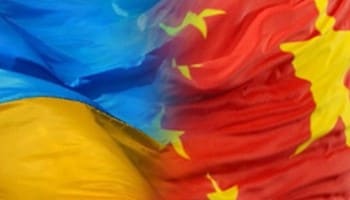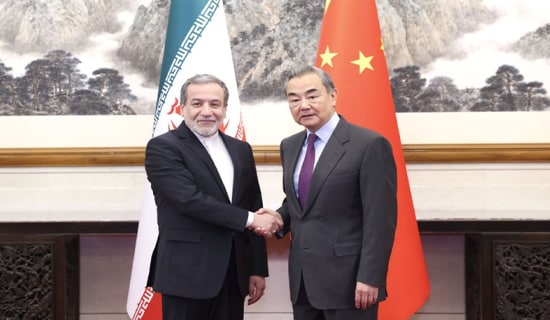On March 13, 2022, the Chinese media outlet Duowei News published an article titled "How Much Has Ukraine Helped China's Military Modernization?" The article reviews the contribution of Ukrainian military enterprises and experts to the rapid modernization of the Chinese People's Liberation Army's weaponry after the collapse of the Soviet Union. It states that Ukraine, "compared with Russia's reservations and holding back in its arms sales to China," has placed "no restrictions of any kind in its arms sales to China, and indeed contributed enormously to China's military modernization."
Below is the article:[1]

(Source: Ukrinform.net/)
'China Was One Of The Biggest Importers Of Ukrainian Weapons'
"After Ukraine became an independent country, it inherited approximately 35% of the Soviet Union's military industrial production capacity. Not only supersonic fighter jets, but almost all weapons or weapon systems, including intercontinental ballistic missiles, could be available on Ukraine's defense production list, making it the sixth largest arms exporter in the world. China was one of the biggest importers of Ukrainian weapons, from which China benefited tremendously in its own modernization of weapons and military equipment.
"As far as weapons and equipment were concerned, the single biggest help that Ukraine gave to China was none other than the large aircraft carrier Varyag, which later became the first fleet aircraft carrier 'Liaoning' of the Chinese Navy. The Varyag was the second carrier of the Kuznetsov-class, the second-generation aircraft carriers built by the Soviet Union after the Kyiv-class. The hull of it had been constructed and launched in the Soviet era. Its sister aircraft carrier Admiral Kuznetsov, the first carrier of the Kuznetsov-class sailed to the Soviet Northern Fleet from the Nikolayev Shipyard in Ukraine just a month before the collapse of the Soviet Union and eventually became the only aircraft carrier of the Russian Navy.
"The Varyag, the second carrier of the Kuznetsov-class, was ill-fated. After the disintegration of the Soviet Union in 1991, Russia had neither the will nor the economic capability to complete its construction. After the Varyag had been stripped from the Russian Navy, it was handed over to Ukraine to pay off Russia's debts. Neither Ukraine had any economic capability to continue to build it. And Ukraine even did not have the money to dismantle it for scrap metal. The Varyag had to sit idle at the shipyard for years until 1998 when China managed to purchase it ostensibly for use as a floating casino. The tons of the full set of the design drawings of Varyag were also acquired together with the hulk. After Varyag was towed for almost two years to Dalian, China in 2002, it was rejuvenated and given a new life. After another ten years of refit and reconstruction, the Varyag re-emerged as the brand-new Liaoning in 2012. This fully capable ski-jump aircraft carrier was commissioned into active service by the Chinese Navy as its first fleet aircraft carrier.
"It is worth noting that total four Kyiv-class, the first-generation aircraft carriers, were built for the Soviet Navy. The third carrier Novorossiysk decommissioned in 1993 was bought for scrapping and broken up by a Korean shipyard. The fourth carrier Admiral Gorshkov was sold to India and converted into an active carrier named INS Vikramaditya in the Indian Navy. The first carrier Kyiv and the second carrier Minsk were acquired by China in mid-1990s. After extensive study and testing, they were both turned into tourist attractions as carrier theme parks. After the Nikolayev Shipyard, the only shipyard capable of constructing aircraft carriers in the Soviet Union, had been turned over to Ukraine, Russia actually lost its capability to build any aircraft carrier. The Admiral Kuznetsov, the only aircraft carrier of the Russian Navy, was out of the service and sent to the Murmansk Star Shipyard for refit in 2018. But various accidents occurred during its overhauling, making the refit far from being completed in 2022. In fact, the main responsibility of the Murmansk Star Shipyard in the Soviet era was repairing nuclear submarines while its main business in the Russian era was dismantling nuclear submarines. From 1993 to 2007, it dismantled 32 nuclear submarines, including 22 capable of firing ballistic missiles.
'China Acquired The T-10K-3 And Its Related Data And Materials From Ukraine'
"It is impossible to have a functional aircraft carrier without its carrier-based fighter aircrafts. In the era of Soviet Union, two types of carrier-based aircrafts were designed for the Kuznetsov-class aircraft carriers, the MiG-29K by the Mikoyan Design Bureau and the Su-33 by the Sukhoi Design Bureau. Both were developed based on the Soviet Air Force's front-line fighter MiG-29 and the Soviet Air Defense Force's anti-aircraft interceptor fighter Su-27. China chose the heavy fighter Su-27 to develop its carrier-based fighters just like Russia. It was also consistent with the decision by the Chinese Air Force to purchase the Su-27 fighters instead of the MiG-29s. India's aircraft carrier Vikramaditya had to go with the MiG-29K as it was subject to its medium-sized tonnage.
"China managed to acquire the technology transfer of the Su-27, including a full production line in 1995 and began licensed production of the Su-27 as J-11. After the successful localized production of the Su-27, the experience gained from the J-11 prompted China to press further with the development of an improved and more domesticated version known as the J-11B.
"Although China had acquired the capability to independently develop and improve the Su-27 fighter jets, the development of carrier-based fighters posed a brand-new challenge to China. But China acquired the T-10K-3 and its related data and materials from Ukraine. It was one of the prototypes of the Su-33 carrier-based fighter jet. This acquisition provided China with a much-needed and valuable boost, making it possible for China to develop its carrier-based fighter aircraft, the J-15. It can be said that the technology from Ukraine has contributed tremendously to the construction of China's aircraft carriers.
"Besides, the Zubr-class air-cushioned landing crafts that China plans to use for its military reunification with Taiwan were also acquired from Ukraine. Two of them were built in Ukraine while two others were built in China. Ukraine transferred all the technical data to China as well, making it possible for China to fully localize its production. The result of it was the 958-type air-cushioned landing craft, which could transport a fully armed amphibious landing company to beaches at a time. The development of the Chinese Changjian-10 cruise missile was also closely connected with the Soviet Kh-55 air-to-surface missile acquired through Ukraine. It was the main Soviet air-launched cruise missile with a range of 2500 kilometers.
"The engine used in the Chinese L-15 trainer, also known as the Trainer-10, came from the Ukrainian Motor Sich, one of the largest engine manufacturers for airplanes and helicopters worldwide. 6TD-2E, the diesel engine used in the MBT-2000 Al-Khalid main battle tank developed by China for Pakistani Army came from the Ukrainian Malyshev Plant. The development of the gas turbine engine by the Chinese Navy was also inseparable from the UGT-25000 gas turbine acquired from the Ukraine's Zorya-Mashproekt Machinery Design, Research and Production Complex. At first, Ukraine was not willing to transfer the engine technology to China. But after entering the 21st century, it agreed to the transfer due to its economic distress.
"Compared with Russia's reservations and holding back in its arms sales to China, Ukraine had no restrictions of any kind in its arms sales to China and indeed contributed enormously to China's military modernization. Certainly, after breaking away from the Soviet Union's defense industrial system, Ukraine lacked the capability to continue to maintain and develop such a huge military industrial production system. It was the best choice for Ukraine to sell its technologies in exchange for hard currency. In those years, Ukraine could be described as a treasure trove for countries across the world. South Korea's T-50 and Italy's M-346 trainers were both developed based on the Ukraine's Yak-130 jet trainer.
'The Proliferation Of Technologies For Ballistic Missiles And Cruise Missiles After The Cold War Had Also A Lot To Do With Ukraine'
"The proliferation of technologies for ballistic missiles and cruise missiles after the Cold War had also a lot to do with Ukraine. The cruise missiles developed by South Korea, Iran, India, Pakistan and North Korea were all closely related to the Soviet Kh-55 air-to-surface missile. Whether the technology was obtained from Russia or Ukraine, only the countries involved had knowledge of it. The United States also actively participated in sweeping up inexpensive Soviet technologies following the years after the dissolution of the Soviet Union. The U.S. purchased a large number of Russian D-180 rocket engines because the United States found out that it would save way much more money than doing its own research and development of rocket engines. The purchase had been going on for decades until only recently when the United States imposed sanctions on Russia against its war in Ukraine in late February of 2022. In retaliation, Russia banned the sale of its D-180 rocket engines to the United States.
"But the scientists in the economically distressed Russia and Ukraine after the collapse of the Soviet Union in 1991 were far more valuable than the weapons and military equipment offered by the two countries. The scientific establishment and research institutions in the United States, Germany, Israel, South Korea, Singapore and other countries sent their experts to Russia and Ukraine to recruit those talents with favorable and lavish conditions. South Korea claimed that Ukrainian experts would get their visas and flight tickets together with monthly salaries of thousands of dollars as long as they contacted the South Korean embassy in Ukraine. For the same reason, the Chinese government also launched the 'Double Acquisition Project,' which targeted the Soviet talents and technologies. The Chinese Premier Li Peng said at the time, 'This is a group of outstanding talents who cannot be cultivated even after ten years of efforts. To our country, it is a great and once-in-a-lifetime opportunity that must not be missed.'
"Of course, it had not been all smooth sailing and without glitches in the Chinese and Ukrainian military cooperation. A Chinese company's acquisition of Motor Sich was rejected. To some extent, Motor Sich, as a large aero-engine researcher and manufacturer, had been living on its past gains since the collapse of the Soviet Union, being pretty much shored up by the orders from China. But at the instigation of the United States, the Ukrainian government scrapped the deal in 2021 and announced the plans to nationalize Motor Sich due to its strategic importance to national defense. It is worth noting that the acquisition deal took a sharp turn after the current Ukrainian President Volodymyr Zelensky came to power in 2019. As a pure business deal, the acquisition of Motor Sich was optional, not a must for China, but it was Motor Sich that actually needed China much more than the other way around."
[1] Dwnews.com, March 13, 2022.




